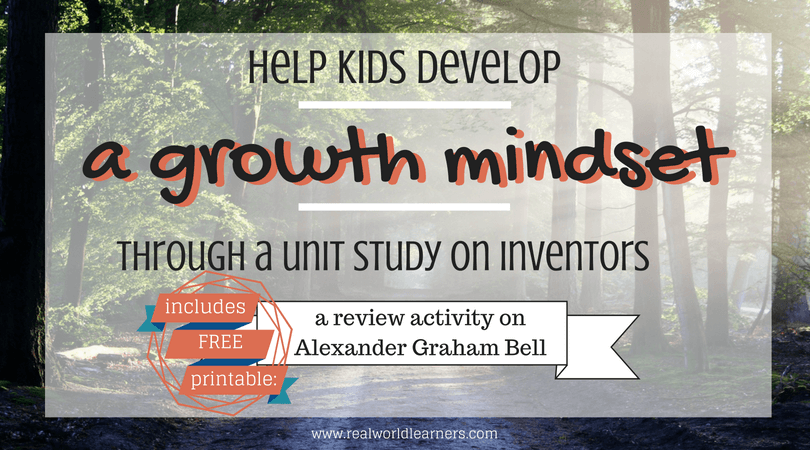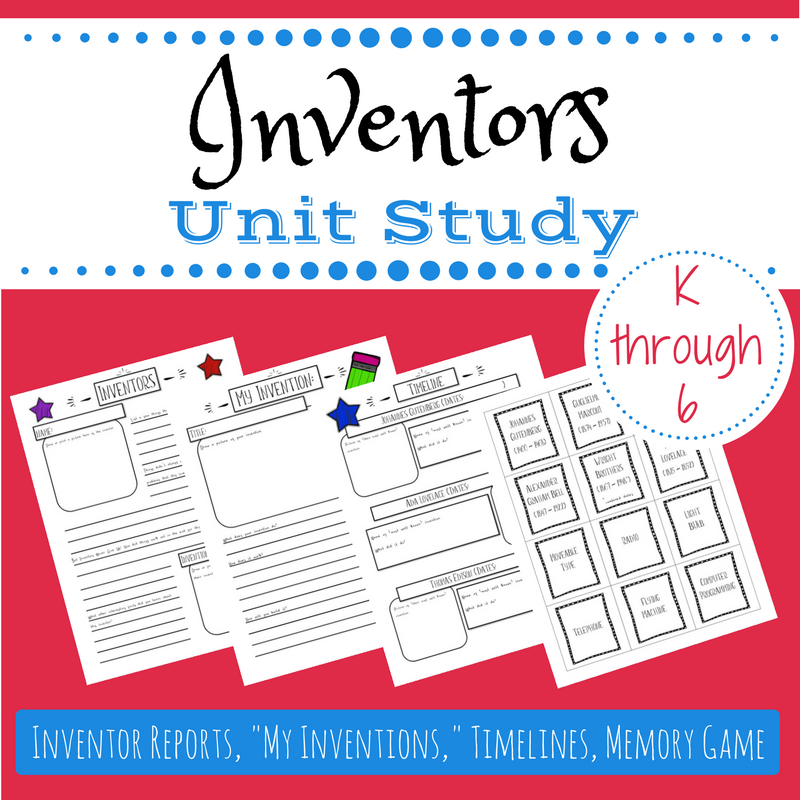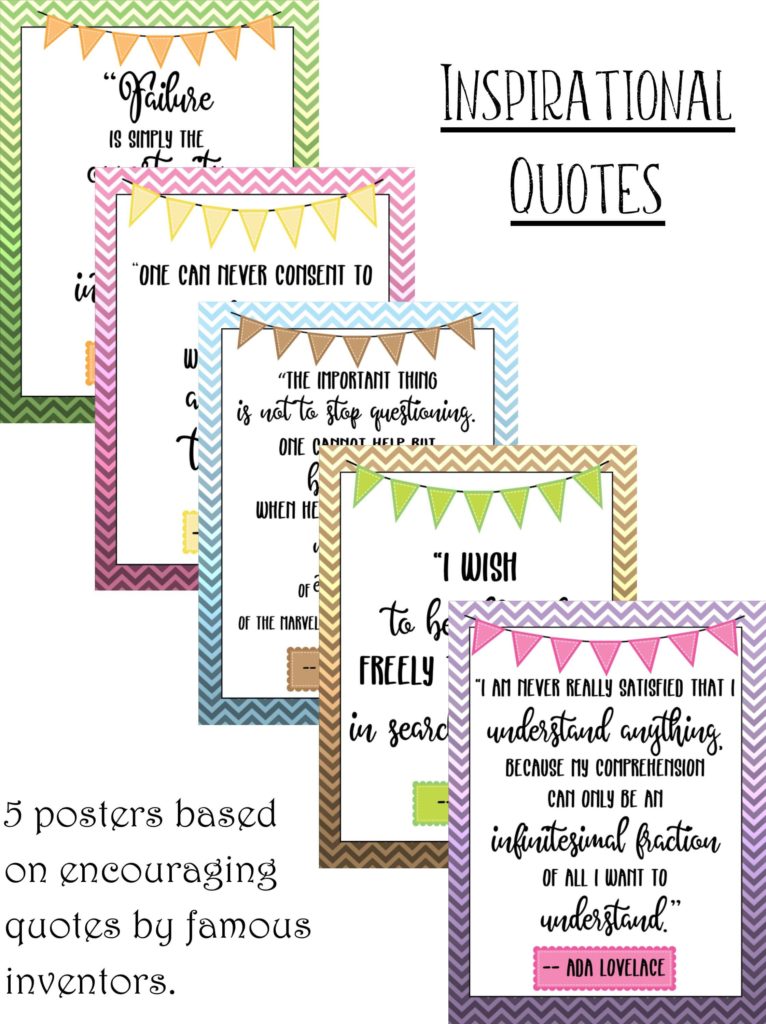Help kids develop a growth mindset through a unit study on Inventors
This article is part of a blog series on the Who Was? (R) What Was? Where Is? books, hosted by Anne at http://www.mylearningtable.com.

This post contains affiliate links. See my disclosure and privacy policy for more information.
We’ve been easing our way into a natural homeschooling lifestyle since our kids were born. During their preschool years, a lot of educational experiences centered around conversations we had with them, based on their interests and questions. This often led into further conversations that would pop up here and there in a wide variety of contexts, or extension activities that were simple to incorporate in an engaging way.
One of these first “lines” of conversation that kept weaving its way through our days was Inventors. I found that it was a very natural approach to a beginning study on history, since we could talk about life in the “old fashioned days” in a positive, interesting way without having to focus on a lot of the negative elements that are better understood and processed in later years.
Whenever I would mention something about what life was like before television, or cell phones, or microwaves, or toilets … etc., I had my boys’ complete attention. It blew their minds a little bit to think about the world in any terms other than what they could see, but they responded well to the mental challenge :).
This easily led into conversations about how things were invented, and who invented them, and what the invention process looked like. We started checking out biographies from the library on different famous inventors and ran across some great series of books that are written for kids. Here’s a short list of a few of the series about inventors that we’ve liked:
- The “Who Was, What was, Where is” series
- Example:
- The “Kids Can Read” series.
- Example:
- The “National Geographic Readers” series
- Example:
- DK biographies
- Example:
- “Getting to Know the World’s Greatest Inventors and Scientists” series
- example:
- and a great stand-alone book that covers the history of inventions:
Help your kids develop a growth mindset
As I read these books with my kids, I was consistently impressed with the element of perseverance that came through clearly in each biography. Every inventor we read about faced incredible odds – in terms of personal disabilities, failures upon failures (before the final breakthrough), lack of material available, or disbelief and discouragement from everyone around them. Many of them had difficulty claiming their ideas before others stole credit for them, and some were even shunned or threatened because of their radical ideas.
But in the face of all of that, they kept going. Something internal drove them to continue testing out their theories, improving their inventions, and asking questions relentlessly.

When no one else believed that they could succeed, they kept going. And they found the answers they were looking for. And they changed the world — making it a safer, healthier, more connected and convenient place to live — one invention at a time.
I believe that a unit study (however big or small you want it to be) on Inventors and their Inventions is one of the best ways to instill a serious and healthy growth mindset in our children.
Through reading these stories, doing hands-on science experiments to re-create these discoveries, studying the engineering behind these inventions, and overall, being impressed with the effort it took at every stage to break through and succeed, our children will learn in a deep and fundamental way that the learning, practising, and questioning process is a vital part of life, and will be encouraged to persevere in the face of difficulty (especially when you are holding tight to an idea you know is worth fighting for!).
Perseverance
I haven’t read a biography yet about an inventor who faced no trials or setbacks. Often the difficulties that they faced pushed them to try harder, and ultimately improved the end result.
As I was reading Who Was Alexander Graham Bell? with my son, this cycle of discouragement/breakthrough was especially clear. His story (and the way this particular book was written) seemed to lend itself to a Fortunately/Unfortunately story-telling style. I decided to write up a series of cards, summarizing his life with this back-and-forth narration, then give my kids a chance to put the cards in order as a review activity following the book.
FREE sequencing activity
If you’d like to use this sequencing activity with your own kids, you can download the pdf file here: Alexander Graham Bell sequencing review activity. (This is a free download from my store with no email required to access it.)
This would also be a fun, unique way to do a book report on an inventor: try to retell the major events in their life and in the process of developing their inventions in a Fortunately/Unfortunately style. (It doesn’t ever work out perfectly, but you can be flexible and allow a few fortunately’s back to back ;).)
I wrote a blog post about creative writing prompts and the value of story-telling; you can find my template for a fortunately/unfortunately story in this post.
More free stuff
Feel free to subscribe using the form below if you’d like to stay updated about future posts with more free printables and notices about limited time freebies in my store. I’d love to have you join the Real-World Learners community!
An Inventors and Inventions Unit Study
 I also created a unit study set of printable activities to go along with our ongoing conversations on the topics. It covers 6 famous inventors, but every part of the unit study has blank templates that can be adapted for use with anyone you want to study.
I also created a unit study set of printable activities to go along with our ongoing conversations on the topics. It covers 6 famous inventors, but every part of the unit study has blank templates that can be adapted for use with anyone you want to study.
This packet consists of the following sections:
- Inventor Report: Print this page as many times as needed to cover each inventor you study.
- Your Own Invention: As students learn about the creative ideas that inspired these inventors to try new things, talk to them about what inventions they would like to make. Print this page as many times as needed to capture their ideas.
- Timeline: Use these pages to help focus in on 6 famous inventors. Print the following blank page to use as many times as needed to fill in your own choices of inventors and inventions.
- Memory Game: Print and cut out these cards. Use the blank cards to fill in your own inventors. Try matching the inventors to the inventions, or use the cards to play a memory game.
I’ve recently updated it to include 5 printable inspirational posters based on famous quotes from several inventors.

You can see the full product description with previews here.
More posts and resources
Be sure to check out the other blog posts in this series! These posts each highlight a book from the Who Was, What Was, Where Is series and provide extension activities, free printables (in most posts), and related resources.

You may also be interested in …
Here are some other books you may enjoy as you study Inventors and help your kids develop a growth mindset.




